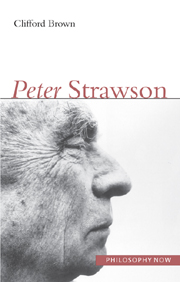Book contents
- Frontmatter
- Contents
- Abbreviations
- Introduction
- 1 “On Referring” and Introduction to Logical Theory: The basic questions
- 2 Individuals: An Essay in Descriptive Metaphysics: Towards a basic ontology
- 3 The Bounds of Sense: Kant's first Critique under analysis
- 4 Skepticism and Naturalism: Hume revisited
- 5 Analysis and Metaphysics: Summing up
- Notes
- Bibliography
- Index
1 - “On Referring” and Introduction to Logical Theory: The basic questions
- Frontmatter
- Contents
- Abbreviations
- Introduction
- 1 “On Referring” and Introduction to Logical Theory: The basic questions
- 2 Individuals: An Essay in Descriptive Metaphysics: Towards a basic ontology
- 3 The Bounds of Sense: Kant's first Critique under analysis
- 4 Skepticism and Naturalism: Hume revisited
- 5 Analysis and Metaphysics: Summing up
- Notes
- Bibliography
- Index
Summary
Looking back at the course of his career in philosophy, Strawson believed in 1998 that the work by which he continues to be best known remains his first, the article “On Referring”. That judgement is probably correct. It is certainly true that “On Referring” is the root of the whole wide spectrum of developments in his later writings. The article is concerned with one particular aspect of the relation between our ordinary language and formal logic, and the concern with that relation is then broadened in his subsequent first book, Introduction to Logical Theory. The two works are therefore appropriately considered together as foundational.
“On Referring”
We commonly use expressions of a certain kind to refer to some individual person, object or event. We use singular demonstrative pronouns (“this” and “that”), proper names (“Peter Strawson”), singular pronouns (“I”, “you”, “it”), and we use the definite article followed by a noun in the singular (“the table”, “the king of France”). The members of the last of those four classes are called definite descriptions, and they constitute the source of a number of questions that are simultaneously grammatical, logical and ontological. Those questions have a long history, going back at least to Aristotle, and contemporary efforts to deal with them are a major source and a continuing central concern among contemporary Anglophone philosophers.
- Type
- Chapter
- Information
- Peter Strawson , pp. 17 - 50Publisher: Acumen PublishingPrint publication year: 2006



